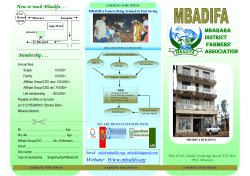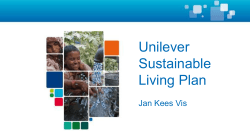
CHAPTER-II SOCIO-ECONOMIC AND PSYCHOGRAPHIC PROFILE OF THE SAMPLE FARMERS
CHAPTER-II SOCIO-ECONOMIC AND PSYCHOGRAPHIC PROFILE OF THE SAMPLE FARMERS An attempt is made in this chapter to present the socio-economic and psychographic profile of the farmers who adopted drip irrigation technology which saves the invaluable natural resources-water in considerable proportions. The said profile includes Place Age Social status Size of the farmer Innovative behaviour Technology induced Management orientation Risk taking behavior Member of WUA 49 RESULTS AND ANALYSIS Table-2.1 Place Place Number of farmers Percent Chillavaripalli Mukundapuram Total Cumulative Percent 125 62.5 62.5 75 37.5 100.0 200 100.0 Source: Primary data Place 140 125 120 100 75 80 Series1 60 40 20 0 Chillavaripalli Mukundapuram Table-2.1 refers to the distribution of the sample farmers by their place. It is observed that 62.5 percent of the sample farmers are drawn Chillavaripalli of Narapala mandal and 37.5 percent are drawn from Mukundapuram village of Garladinne mandal of Ananthapur district of Andhra Pradesh. 50 Table-2.2 Age Age(Years) Number of farmers Percent Cumulative Percent 25-35 48 24.0 24.0 35-45 128 64.0 88.0 24 12.0 100.0 200 100.0 Above 45 Total Source: Primary data Age 140 120 100 80 Series1 128 60 40 20 0 Series1 48 24 25-35 35-45 Above 45 48 128 24 Table-2.2 refers to the distribution of the sample farmers by their age. It is observed that 24 percent of the sample farmers are found in the age range of 2535 years, 64 percent in the age range of 35-45 years and 12 percent are in the age range of above 45 years. Thus, majority of the sample farmers are found to be relatively young. 51 Table-2.3 Social status Category Number of farmers Percent Cumulative Percent OC 119 59.5 59.5 BC 42 21.0 80.5 SC 26 13.0 93.5 ST 13 6.5 100.0 200 100.0 Total Source: Primary data Social status 120 100 80 60 40 20 0 Series1 OC BC SC ST 119 42 26 13 Table-2.3 refers to the distribution of the sample farmers by their social status. It is observed that 59.5 percent of the sample farmers are drawn from socially advanced castes, 21 percent are drawn from backward castes, 13 percent are from scheduled castes and 6.5 percent are drawn from scheduled tribes. Thus, majority of the farmers are drawn from socially advanced castes. 52 Table-2.4 Size of the farmer Size of the farmer Number of farmers Percent Cumulative Percent Marginal 19 9.5 9.5 Small 28 14.0 23.5 106 53.0 76.5 47 23.5 100.0 200 100.0 Medium Big Total Source: Primary data Size of the farmer Marginal, 19 Big, 47 Small, 28 Medium, 106 Table-2.4 refers to the distribution of the sample farmers by their farm size. It is observed that 9.5 percent of the sample farmers are drawn marginal farmers, 14 percent are small farmers, 53 percent are medium farmers and 23.5 percent are big farmers. Thus, majority of the farmers are of medium category. 53 Table-2.5 Innovative behaviour Number of farmers Percent Level Low Cumulative Percent 26 13.0 13.0 126 63.0 76.0 High 48 24.0 100.0 Total 200 100.0 Moderate Source: Primary data Innovative behavior 140 126 120 100 80 60 48 40 20 26 0 Low Moderate High Series1 Table-2.5 refers to the distribution of the sample farmers by their innovative behaviour. It is observed that 13 percent of the sample farmers are endowed with low level innovative behaviour, 63 percent with moderate innovative behaviour and 24 percent with high level innovative behaviour. 54 Table-2.6 Technology induced Number of farmers Percent Level Cumulative Percent Low 18 9.0 9.0 Moderate 36 18.0 27.0 High 146 73.0 100.0 Total 200 100.0 Source: Primary data Technology induced 160 146 140 120 100 80 Series1 60 40 20 36 18 0 Low Moderate High Table-2.6 refers to the distribution of the sample farmers by their technology inducing behaviour. It is observed that 9 percent of the sample farmers are endowed with low level technology inducing behaviour, 18 percent with moderate technology inducing behaviour and 73 percent with high level technology inducing behaviour. 55 Table-2.7 Management orientation Level Number of farmers Percent Cumulative Percent Low 124 62.0 62.0 Moderate 58 29.0 91.0 High 18 9.0 100.0 Total 200 100.0 Source: Primary data Management orientation 140 120 100 80 60 Series2 124 40 58 20 18 0 Low Moderate High Table-2.7 refers to the distribution of the sample farmers by their management orientation. It is observed that 62 percent of the sample farmers are endowed with low level management orientation, 29 percent with moderate management orientation and 9 percent with high level management orientation. 56 Table-2.8 Risk taking behavior Number of farmers Percent Cumulative Percent Level Low 22 11.0 11.0 132 66.0 77.0 High 46 23.0 100.0 Total 200 100.0 Moderate Source: Primary data Risk taking behavior 150 100 Series1 50 0 Series1 Low Moderate High 22 132 46 Table-2.8 refers to the distribution of the sample farmers by their risk taking behaviour. It is observed that 11 percent of the sample farmers are endowed with low level risk taking behaviour, 66 percent with moderate risk taking behaviour and 23 percent with high level risk taking behaviour. 57 Table-2.9 Member of WUA Member of WUA Number of farmers Percent Cumulative Percent Yes No Total 188 94.0 94.0 12 6.0 100.0 200 100.0 Source: Primary data Member of WUA 200 180 160 140 120 100 80 60 40 20 0 188 Series1 12 Yes No Table-2.9 refers to the distribution of the sample farmers by their membership in WUA. It is observed that 94 percent of the sample farmers members of water users association and 6 percent did not take the membership. 58 Thus it is concluded that the sample composition consists of banana growers (62.5percent) and citrus growers (37.5 percent). Majority of the sample farmers are relatively young, drawn mostly from socially advanced castes, belonged to medium farm size, endowed with moderate level innovative behaviour, highly technology induced, low management orientation, moderately risk taking behaviour and members of water users associations. 59
© Copyright 2025









